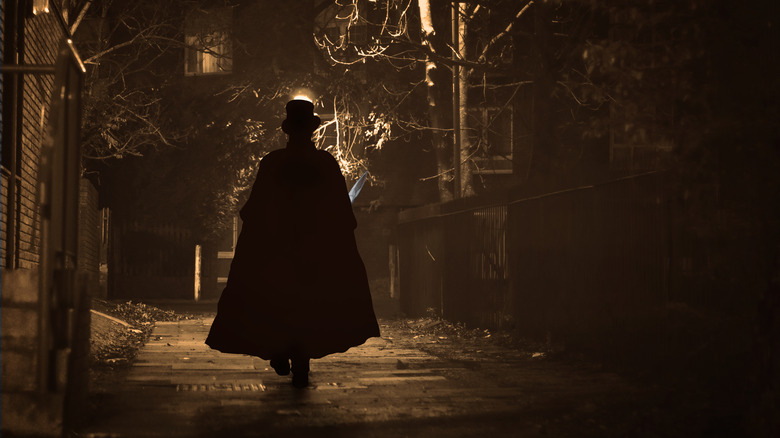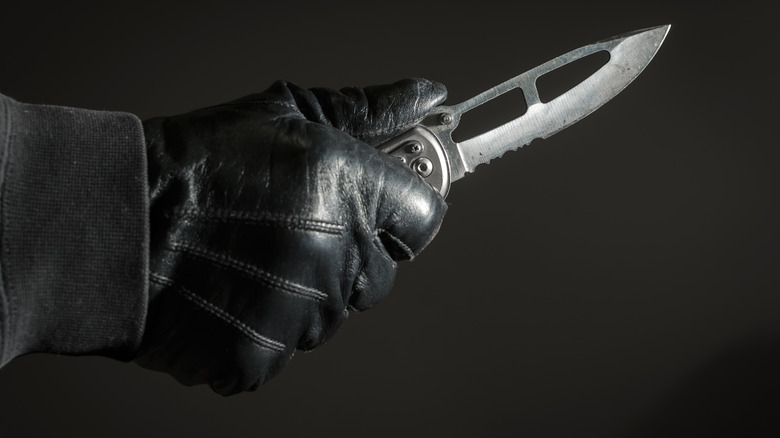The Untold Truth Of The Atlanta Ripper
Between 1911 and 1912, an estimated 20 women were abducted and brutally murdered in Atlanta, Georgia. As reported by Medium, all the serial killer's victims were attractive Black or biracial women from impoverished communities. According to a Baltimore Sun article, provided by Newspapers.com, the women were also "neatly dressed." Crime Capsule reports most of the women were abducted at night, while they were walking alone.
As reported by Ranker, a vast majority of the victims were approached from behind, struck in the head, and transported to a more secluded location, where they were tortured, mutilated, and ultimately killed. Arcadia Publishing reports most of the women were killed on Saturday nights and their bodies were discovered the following day.
As reported by Crime Capsule, most of the victims were part of Atlanta's tight-knit Black community, which formed amid ongoing racial tensions in the region. Although the state was plagued with race-related violence and persistent segregation, the Black community worked together to build strong connections within their neighborhoods.
At the time, no suspects were identified, and the women appeared to be chosen at random. The community became frustrated with the media's apparent lack of interest in the crimes and the authorities' failure to identify a viable suspect and make an arrest.
Although the Atlanta Ripper seemingly vanished by 1912, and police eventually identified several suspects, the identity of the brutal killer was never conclusively proved, leaving the murders unsolved.
There were similarities between the Atlanta Ripper and Jack the Ripper
The brutal nature of the murders led to a natural comparison between the Atlanta killer and London's Jack the Ripper. As reported by History, Jack the Ripper killed at least five women in 1888. Although he did not kill a large number of women, the sheer brutality of the murders gained worldwide attention. Jack the Ripper did not simply kill his victims, he tortured them and mutilated their bodies.
Like Jack the Ripper, the Atlanta killer used a number of methods to torture, mutilate, and kill his victims. He was therefore dubbed the Atlanta Ripper.
As reported by Ranker, Lena Sharp's body was found near a set of railroad tracks. According to reports, her throat was slashed so deeply that she was nearly decapitated. Sadie Holley's throat was slashed as well. However, she also suffered multiple wounds to the head, which were inflicted with a large rock. Like the others, Addie Watts' throat was also cut, but she was also beaten about the head with a coupling pin, which fell off a train.
The Atlanta Ripper also linked himself to Jack the Ripper on two different occasions. While assaulting one of his victims, the killer reportedly said, "Jack the Ripper ain't dead yet." Ranker reports the killer also left a number of handwritten letters taped to fireboxes throughout the city. The taunting letters, which said the killer would "cut the throats of all Negro women," was signed "Jack the Ripper."
The Atlanta Ripper did not make the front page until the eighth victim was found
Mary "Belle" Walker, who was killed on May 27, 1911, is believed to be the Atlanta Ripper's first victim. As reported by Ranker, deaths and murders in the Black community were rarely reported in newspapers in the early 1900s. However, Belle Walker's murder drew attention due to her stunning beauty and the sheer brutality of her death.
The barbaric killings continued every few weeks, but authorities did not immediately realize they were dealing with a serial killer, and the media did not take enough interest in the killings to feature them on the front page until the body of the eighth victim was found.
Ranker reports Sadie Holley, who was killed on July 10, 1911, was the first of the Atlanta Ripper's victims to appear on the front page of The Atlanta Constitution. Like several other victims, Sadie's throat was slashed, and her skull was crushed with a rock. Her body was found dumped in a nearby field. Although her shoes were missing, authorities did not find any evidence that would lead them to her killer.
By the time authorities discovered Sadie's body, they were beginning to theorize that the murders were committed by the same person. An article published by the Baltimore Sun, which was provided by Newspapers.com, said the killer appeared to be experiencing "an awful mania of a diseased mind."
Two women survived the Atlanta Ripper
Although an estimated 20 women were killed by the Atlanta Ripper, two women managed to escape.
As reported by Ranker, 20-year-old Emma Lou Sharpe became concerned when her mother failed to return home from the market when expected. As the Atlanta Ripper targeted women matching her mother's description, Emma Lou feared the worst. In an attempt to find her mother, she followed the path her mother wound have taken from the market to their home. Along the way, she met a man, who stepped out onto the sidewalk and blocked her path.
According to Emma Lou, the man said, "I never hurt girls like you." However, he then pulled out a knife and stabbed her in the back. Thankfully, she was not fatally wounded and managed to escape. Her mother, however, was found dead the following day.
Ranker reports Emma Lou described her attacker as a tall Black man with broad shoulders. She also noted that he was wearing a black hat with a wide brim.
Days later, Mary Yedell was walking home from work when she heard someone whistling. Mary became alarmed when the person, who she also described as a tall Black man, approached her in a threatening manner. She immediately began screaming for her boss, who rushed to the scene. However, the man, who was believed to be the Atlanta Ripper, managed to vanish without a trace.
Several suspects were arrested, but the case remains unsolved
Although the Atlanta Ripper killings remain unsolved, authorities arrested multiple people and charged them with the murders. As reported by Georgia Mysteries, Henry Brown, John Daniel, Todd Henderson, Henry Huff, and Charlie Owens were all arrested and imprisoned for the Atlanta Ripper killings. However, only one of the men was convicted, and his conviction remains a point of heated controversy.
John Daniel was released from jail, as the killings continued after he was incarcerated. Although it has been suggested that he may have had a partner, there was no conclusive proof linking him to the crimes.
Henry Brown, who confessed to the Atlanta Ripper killings, was acquitted when it was revealed that his confession was coerced. Georgia Mysteries reports Brown was beaten by police officers until he confessed to the crime.
Todd Henderson and Henry Huff were both tried for the Atlanta Ripper killings. However, they were both ultimately found not guilty.
Charlie Owens was charged in only one of the killings attributed to the Atlanta Ripper. Although he was found guilty, the conviction remains controversial. As reported by Georgia Mysteries, the murders continued for some time after Charlie Owens was incarcerated.
Another suspect, who was never arrested in the case, was a man named Jim Conley. Conley, who fit the description given by witnesses and those who escaped the Atlanta Ripper, was identified as the killer by Detective W. J. Burns. However, nobody ever followed up on the accusations.
A grand jury declared the Atlanta Ripper was a myth
In March 1912, a grand jury convened and concluded the Atlanta Ripper was a myth. As reported by Medium, the grand jury determined the killings were each committed by a different man and were in no way related. They also determined the women were likely killed in a fit of jealousy after they were found to be engaging in "immoral conduct."
Although most of the murders attributed to the Atlanta Ripper were quite similar, critics argue that the region was notorious for violent crime. As none of the murders were solved, it is unknown whether there was one or more Atlanta Rippers, or how many of the killings were committed by a copycat.
It is also unclear when the Atlanta Ripper killings began or when they actually stopped.
As reported by Medium, it is widely believed that Mary "Belle" Walker, who was killed on May 27, 1911, was the Atlanta Ripper's first victim. However, a 1911 article in The Atlanta Constitution suggested the killings actually began in 1909. Although most sources report the Atlanta Ripper stopped killing by 1912, others suggest the Atlanta Ripper was active until 1915.





